ABSTRACTION AS ORNAMENT Joel Danilewitz on Walter Price at Greene Naftali, New York
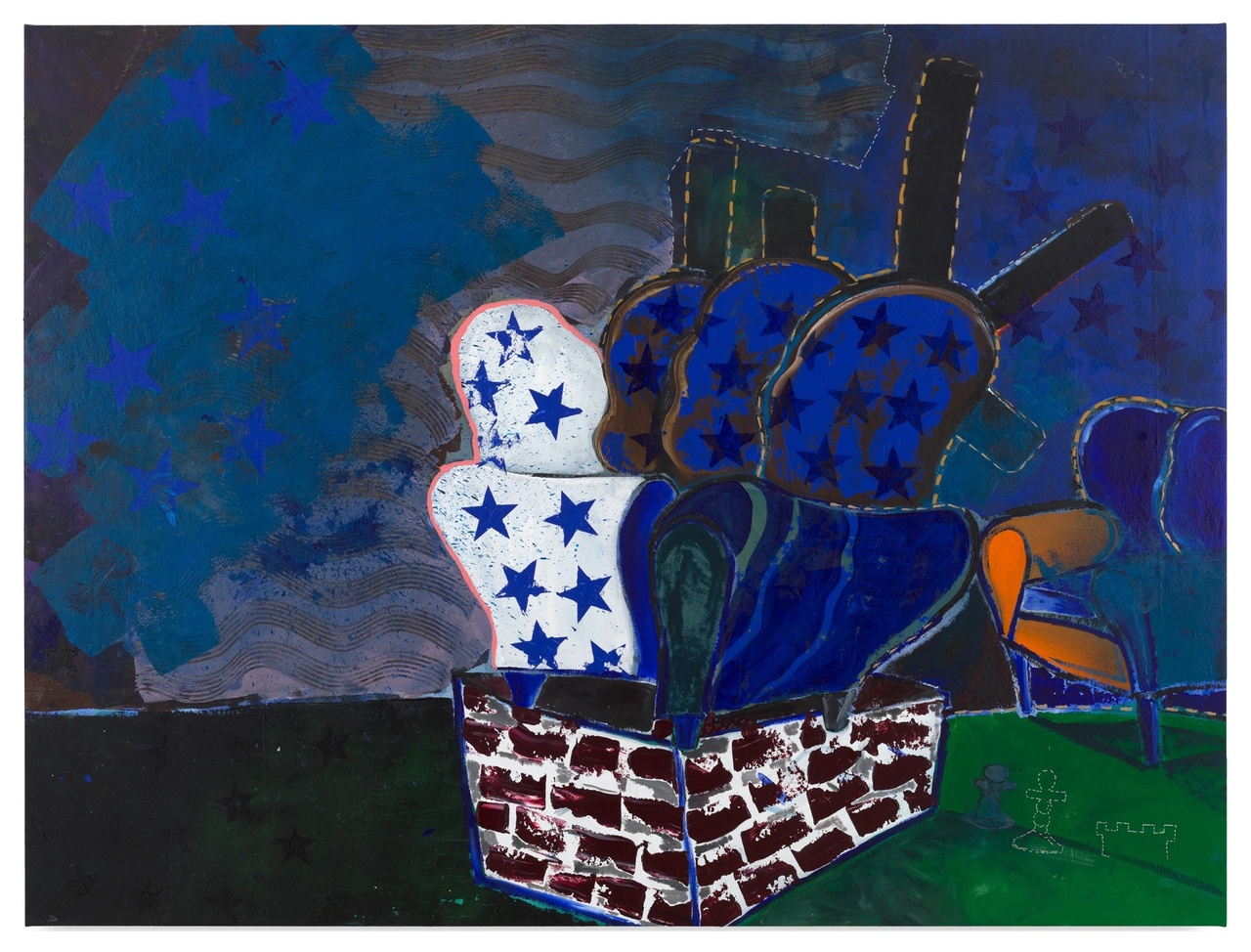
Walter Price, “Harrowing Winds,” 2024
Walter Price is a loose painter. His colors are fluid, his depictions are nebulous, and his paintings gesture toward a litany of abstract processes – all while coalescing around a representational image. The press release for Walter Price’s recent two-floor show at Greene Naftali refers to the artist’s high-wire act of “threading abstraction with an evocative realism.” [1] According to previous curatorial texts about Price’s shows, this “brisk blend” [2] of figuration with abstraction is his modus operandi; whether he is working between these methods or attempting to harmonize them, this binary is always in view. Price does play along such bifurcated lines, however, this paradigm saps the work of its intent, undercutting approaches that could enhance Price’s ideas or heighten the pictorial tension that such press releases often promise. As a result, his practice appears to use abstraction as an ornamentation for his ideas rather than placing it in conversation with his evocative imagery. His focus on the dreary violence of patriotism yields a catalogue of recurring objects, often of domestic or suburban utility, that he surrounds with abstract forms or places in abstract contexts, though occasionally these elements do not share equal footing on the canvas.
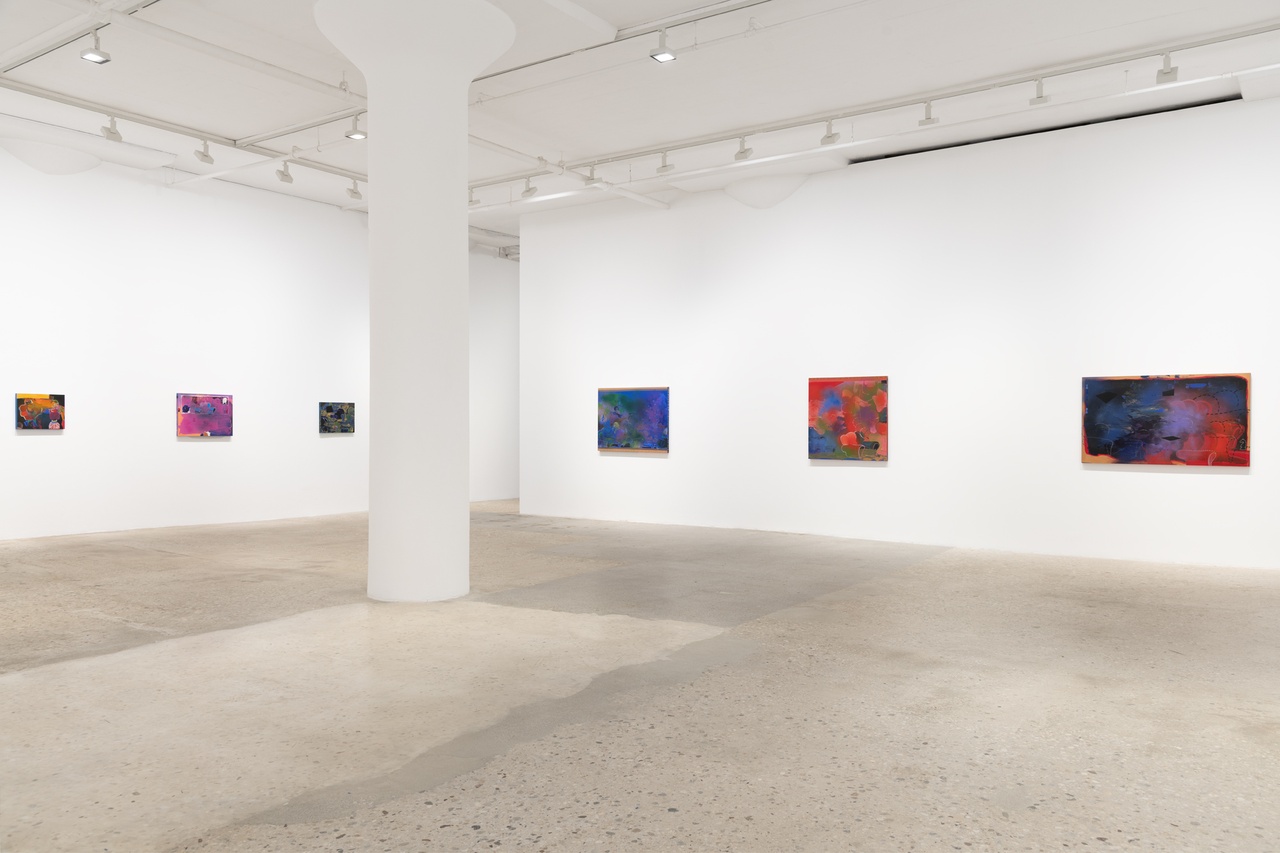
“Walter Price: Pearl Lines,” Greene Naftali, New York, 2025
Price’s career is an exercise in repetition: In the sixth iteration of the “Pearl Lines” exhibition over seven years, the artist makes explicit references to the dull brutality of white America. Filling the ground and first floor of the gallery with new works that elaborate on these themes to the point of near exhaustion, Price stamps opaque purplish blue stars and stripes onto several of the paintings both in the entrance and throughout the exhibition. A former navy officer whose education was financed through the GI Bill, he uses a lexicon of twisted Americana that exposes the broken American dream and devises a range of approaches to bring forth the ironical dialectic that Jasper Johns innovated in his own portrayals of the American flag. This technique proves to be sporadically fruitful for Price, such as in Harrowing Winds (2024), which hangs prominently in the ground floor’s central room. Here, Price balances an absurd construction of interlocking armchairs, each rendered in a starry upholstery. This illogical piece of furniture, stacked precariously over a brick chimney, ostensibly invites us to ridicule the dubious American dream. The armchairs also conjure a therapist’s office, in which Price diagnoses the nation’s collective malaise.
But applications of abstract gestures can detract from his withering criticisms of middle America, signaling a non-representational aesthetic without welding it to, or, alternatively, divorcing it from figuration. By the time we get to Entangled in the Complex Mesh of Ideas (2025) [3] in the adjacent room, Price has established his glossary of motifs: crowds of people moving beneath wet skies, stuttering lines reminiscent of blueprint sketches or road marks, athletes – the American dream unraveled as a nightmare. However, in this work, the delineated armchairs are detached from the sprays of hot pink, daubs of blue, and scrapes of green that trawl the canvas. The colors cohere and yet they are only an extrinsic addition to the chairs – or perhaps it’s the furniture which is superfluous. Both the abstract and the figurative components are tenuously attached to one another, and walking toward the back of the ground floor, one seeks out an echo between the two modes.
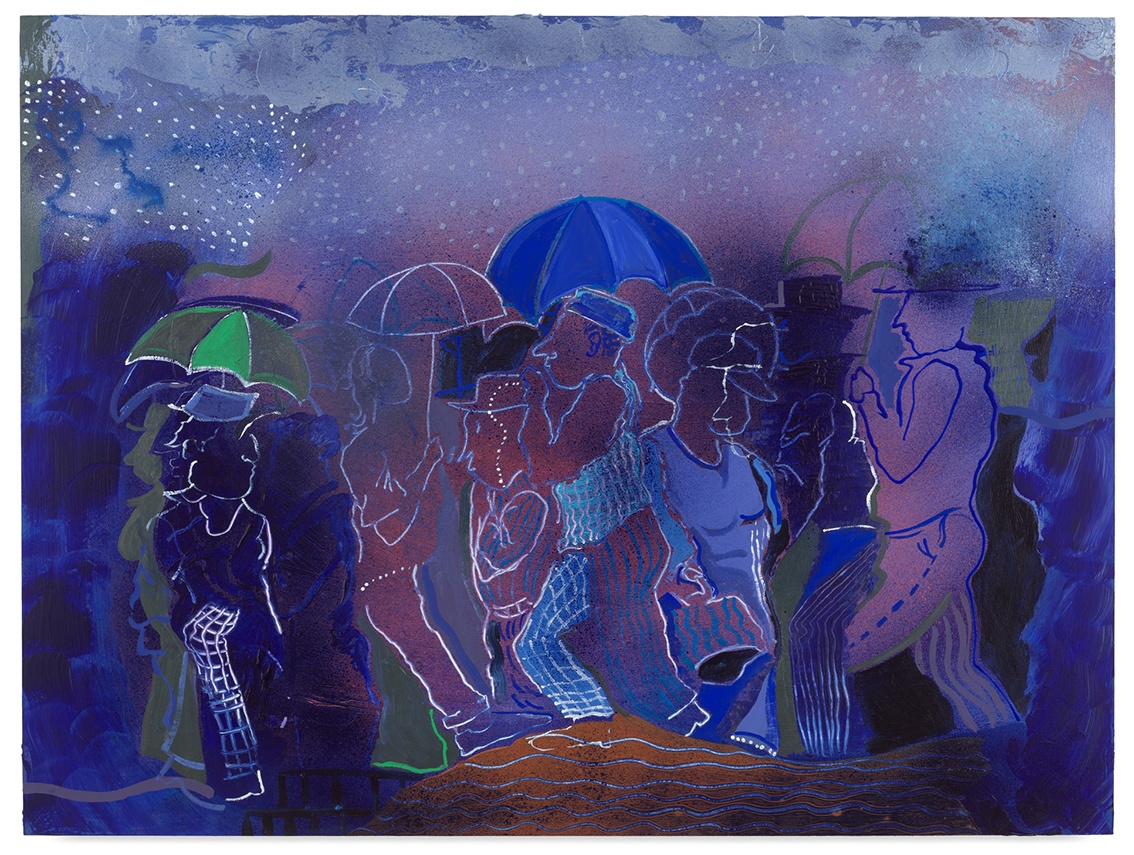
Walter Price, “It has to rain before you can see where all the leaks are at,” 2024
Price has cited Jacob Lawrence as a fundamental influence [4] – a parallel that seems easy to draw yet can’t be sustained when one examines the artists together. In a painting like Lawrence’s The Butcher Shop (1938), the artist articulates horizontal and vertical lines across slanted rain, oblique cars with morose Black drivers, scaffolding, aslope windows, a striped awning, and hanging meats. What converges on this plane parallels the work’s content: Lawrence has transcribed varying levels of segregation and discrimination against Black people by white civil society onto the field of vision, dispersing its effects across the canvas. Price, similar to Lawrence, has several crowded, rainy days populated with gloomy figures, such as It has to rain before you can see where all the leaks are at (2025). [5] But in his work, the varying blues and purples speak to melancholia in a way that feels too literal, as if supposed to simulate depression, i.e., the blues. Unlike Lawrence’s subjects, Price’s crowd precedes the surroundings, as though he squeegeed or sponged paint around the figures. The work does not suggest interlacing structures, nor does Price push his imagery into any tense or interesting stand-offs with the surrounding washes of color, instead letting symbolism devolve into murkiness.
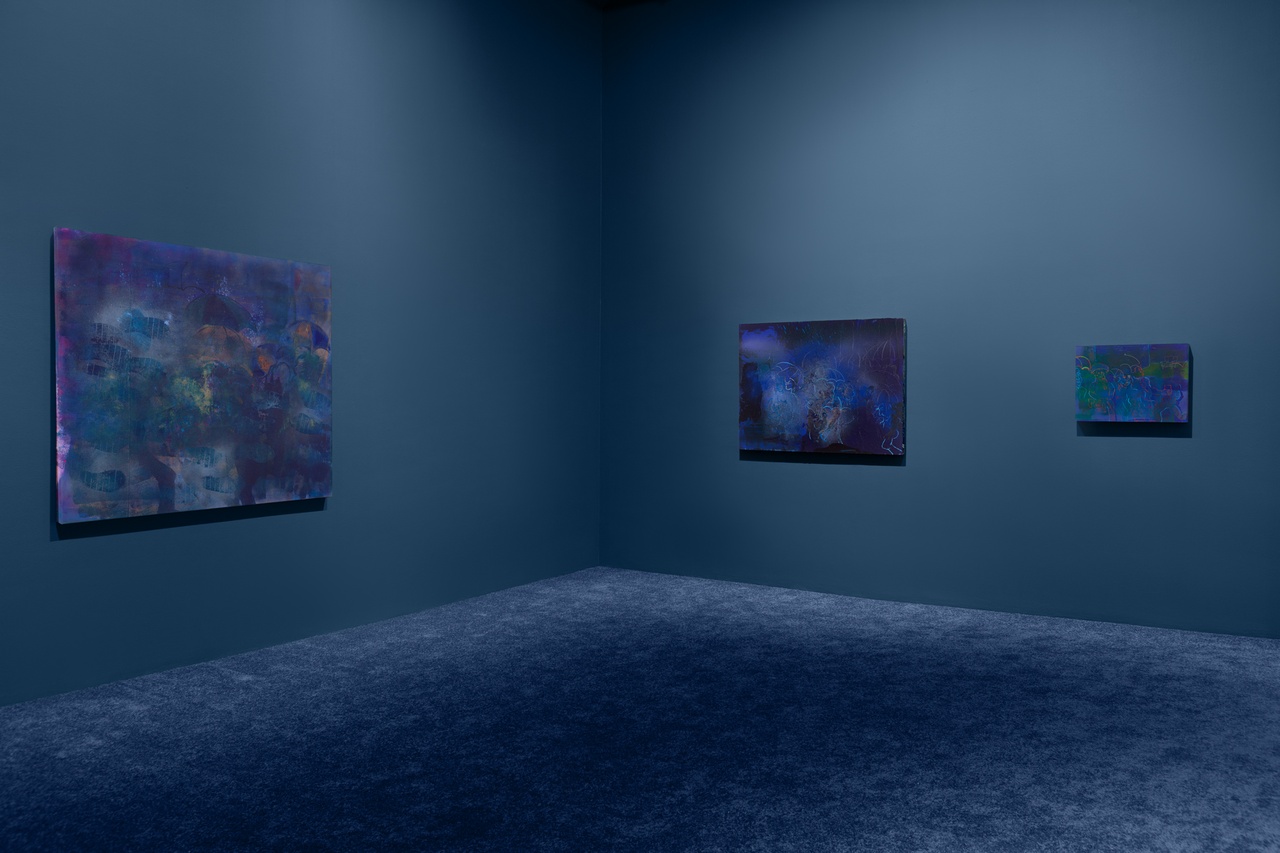
“Walter Price: Pearl Lines,” Greene Naftali, New York, 2025
The first floor, a profusion of soporific navy, culminates in a jewel-toned indigo room with some of Price’s most crepuscular works. This additional setting for Price’s paintings only stultifies the whole endeavor and has a kind of neurasthenic effect on the passing viewer. The umbrellas-as-shelters; the infinite blue; the fleeting characters and their modestly rendered settings; a weary modernity à la Gustave Caillebotte’s Paris Street; Rainy Day (1877): all of this makes moving through Price’s world a dense yet lethargic effort. Indeed, as a former military officer, Price invokes the repetitive drills and training that structured his life. His ability to replicate interminable, suppressed longing, refracted through the itinerant structures he uses to present his work, is a potential argument for the sheer amount of objects in the show. Yet without a strong interplay between the imaginative and material aspects of his work, the exhibition periodically recedes into a muddled swirl of haphazard painterly mechanism.
Several of Price’s works on the ground floor are direct at first, with clear and ample commentary on the pressures exerted by white America onto society writ large. He attempts to fuse these ideas to an abstract mode in works like The Mind Is Like a Parachute (2025), but whether it’s the more realistic components or more gestural ones that are incomplete, neither aid the other in ennobling the object, nor do they provoke interesting tension between each other. One wishes for realism and non-objective art to collide more explosively in Price’s art, but instead, the “figurative and abstract” constituents feel additive, less playing off one another so much as existing, disinterestedly, side by side.
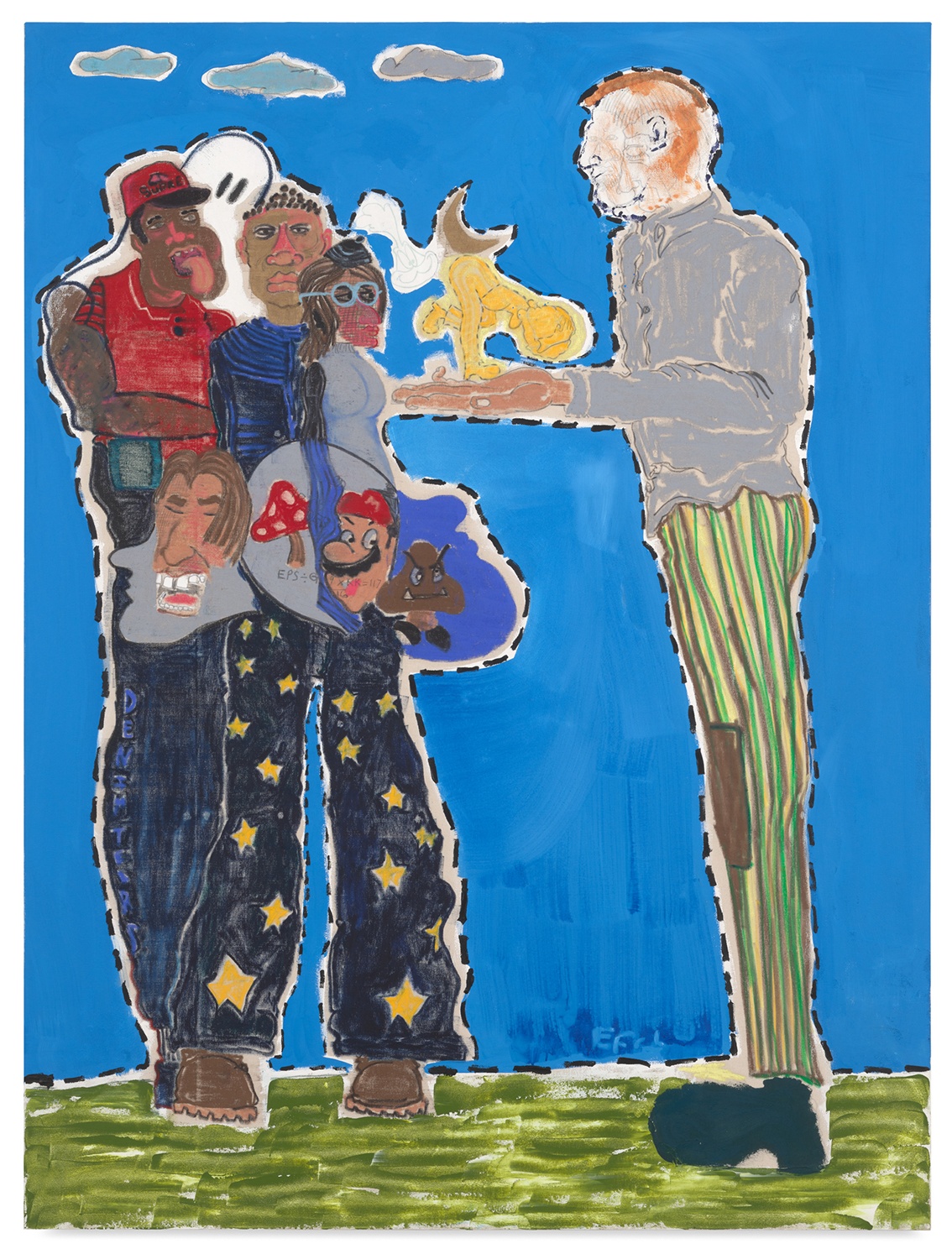
Walter Price, “Are those Amiri jeans?,” 2023
In the gallery’s second space, which is located on the eighth floor, Price’s critiques of an immiserated consumer class become more pronounced. In Drawing 2 (2023) a cartoonishly butch character in a Supreme cap and Spiderman gloves cradles a middle-aged hippie. Piggy-backing the hippie is a clown in red pinstripes that sprouts like a demon from the hippie’s shoulder. Monstrousness abounds. In other works such as Are those Amiri jeans? (2023), figures merge with one another as illustrations of Super Mario and 1-Up Mushrooms impregnate this tricephalous creature. Against solid backgrounds, these characters fall across the canvas in sharp relief, where Price marries the grotesque with the mundane to disquieting effect. It is here that he no longer concerns himself with the contrived opposition between “abstraction” and “figuration” that critics and galleries seem intent on emphasizing in his work. The ink-on-paper works along the rear wall, all titled Clown Shoes (2024), are similarly biting, juxtaposing the clowns’ vacant smiles with surreal, distended-looking humans amidst curtains of stars lifted from the US flag. In dispensing with the dichotomy of abstraction and realism, Price is more resolute, and the illustrations elicit a bright yet decrepit energy that is coeval with the subject matter.
“Walter Price: Pearl Lines,” Greene Naftali, March 6–April 19, 2025.
Joel Danilewitz is a critic and writer. His work on art, literature, and music has been published in Frieze, The Brooklyn Rail, émergent, and others. He is based in New York.
Image credits: Courtesy the artist and Greene Naftali; 1. photo Elisabeth Bernstein; 2. photo Júlia Standovár; 3. photo Elisabeth Bernstein; 4. photo Júlia Standovár; 5. photo Elisabeth Bernstein
Notes
| [1] | See the exhibition page at the Greene Naftali website. |
| [2] | See the 2022 iteration of the exhibition at the Greene Naftali website. |
| [3] | One of two works with the same title, according to the exhibition website checklist (see footnote 1). |
| [4] | “Walter Price with Michelle Grabner” interview, The Brooklyn Rail, October 2024. |
| [5] | See footnote 1. |

